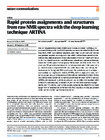Rapid protein assignments and structures from raw NMR spectra with the deep learning technique ARTINA

Open access
Date
2022-10-18Type
- Journal Article
Abstract
Nuclear Magnetic Resonance (NMR) spectroscopy is a major technique in structural biology with over 11,800 protein structures deposited in the Protein Data Bank. NMR can elucidate structures and dynamics of small and medium size proteins in solution, living cells, and solids, but has been limited by the tedious data analysis process. It typically requires weeks or months of manual work of a trained expert to turn NMR measurements into a protein structure. Automation of this process is an open problem, formulated in the field over 30 years ago. We present a solution to this challenge that enables the completely automated analysis of protein NMR data within hours after completing the measurements. Using only NMR spectra and the protein sequence as input, our machine learning-based method, ARTINA, delivers signal positions, resonance assignments, and structures strictly without human intervention. Tested on a 100-protein benchmark comprising 1329 multidimensional NMR spectra, ARTINA demonstrated its ability to solve structures with 1.44 Å median RMSD to the PDB reference and to identify 91.36% correct NMR resonance assignments. ARTINA can be used by non-experts, reducing the effort for a protein assignment or structure determination by NMR essentially to the preparation of the sample and the spectra measurements. Show more
Permanent link
https://doi.org/10.3929/ethz-b-000578209Publication status
publishedExternal links
Journal / series
Nature CommunicationsVolume
Pages / Article No.
Publisher
NatureSubject
Machine learning; Solution-state NMROrganisational unit
03782 - Riek, Roland / Riek, Roland
Funding
891690 - DeepNOE: Leveraging deep learning for protein structure solving at ultra-high resolution on the basis (EC)
More
Show all metadata


